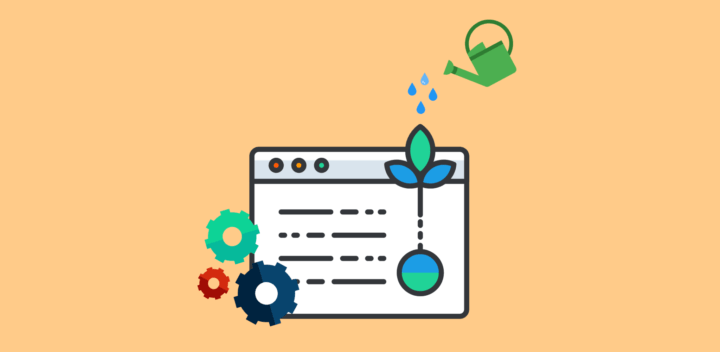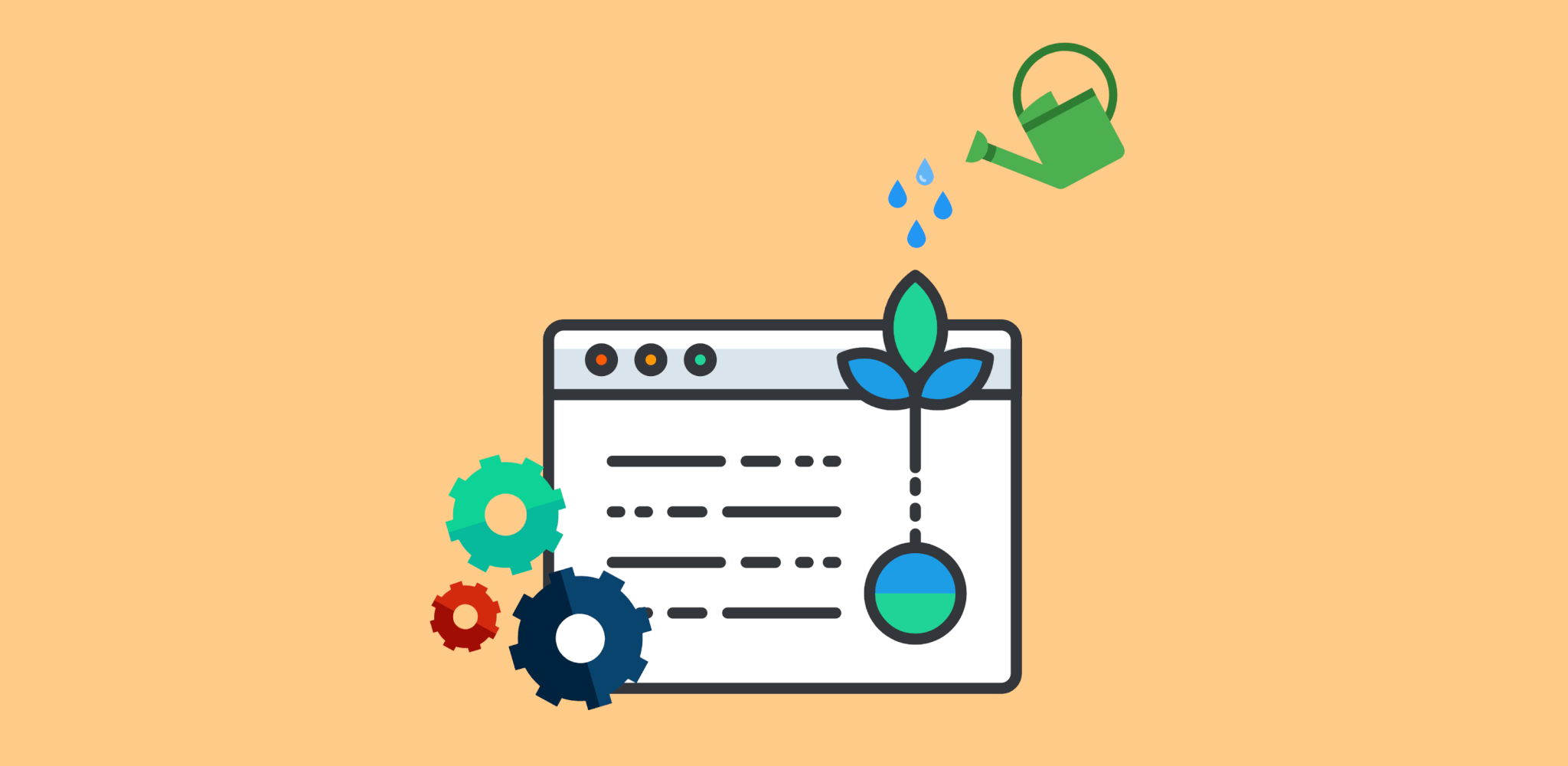What Is a Lead Nurturing Campaign?
Perhaps you’re wondering: “What is lead nurturing?” A lead nurturing campaign is a marketing strategy that is used to build your customer list and increase sales. The lead nurturing campaign does this by providing customers with educational content about the services or products you offer, being responsive when they contact you and following up on leads for a certain period of time.
5 Lead Nurturing Campaign Examples
It is a fact that not all leads engage in the same way.
Some are pretty active, while others are too reluctant to take note of your emails.
Whatever it is, email campaigns continue to be the most preferred communication channel.
Although marketers are adopting multichannel marketing, emails still take the limelight. Hence, automated email drips are a mandate to nurture leads.
1. Welcome Drips
When you sign up or subscribe to a platform, immediately you receive a welcome drip email.
It consists of your first name (which is now very common in almost any email campaign), a short welcome message, an overview of the kind of experience you will have with the brand, and a small milestone to begin with.
The outreach email will mostly be signed off either by the CEO/founder or maybe the marketing person.
Whoever it is, you will instantly know it is a real person (avoiding spam folders or worse).
This helps in building a bond with the brand.
You keep receiving emails from this same person which creates an online relationship.
Later, when this person actually gives you a call, you can instantly relate.
Below is one such welcome email from Smart Insights that one of my colleagues had received.
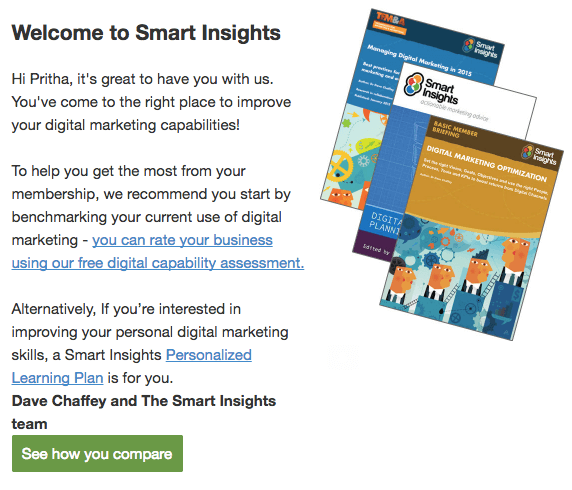
If you look closely, it instantly tells you how Smart Insights will help you in ‘improving your digital marketing capabilities’.
To get things rolling, Smart Insights offers a customized recommendation and also an “alternative”.
Everyone wants to know their competitive ranking, which is why the green CTA with “See how you compare” words strikes the perfect chord.
2. Onboarding Emails
Welcome emails are usually followed by onboarding emails.
Onboarding email drips are designed to help you get acquainted with the brand and its various resources.
Onboarding email drips are designed to help you get acquainted with the brand and its various resources. Share on XThese emails are based on behavior-tracking, because often you might receive emails helping you pick up from the exact point where you got stuck while using the product/services.
Check out this onboarding email from Dropbox:
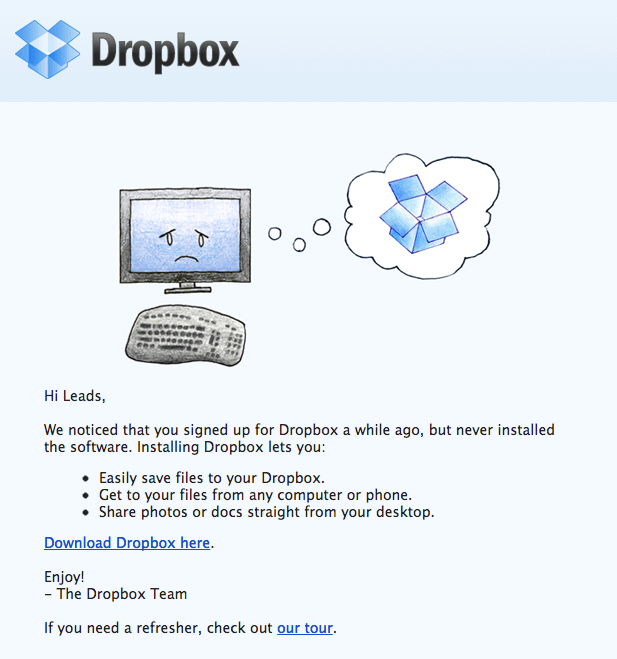
This email can also be tagged as a re-engagement email.
It tries to nudge users to download the desktop version of Dropbox while simultaneously telling the benefits of doing so.
The clean design template of Dropbox is my favorite kind here.
Another favorite is this email from Canva, a designing platform.
I received this email while I was designing wedding cards for my own wedding.
I continuously looked for wedding card templates and kept editing quite a few numbers of them.
And then I woke up to this email that clearly tracked my activities and sent me some handy tips.
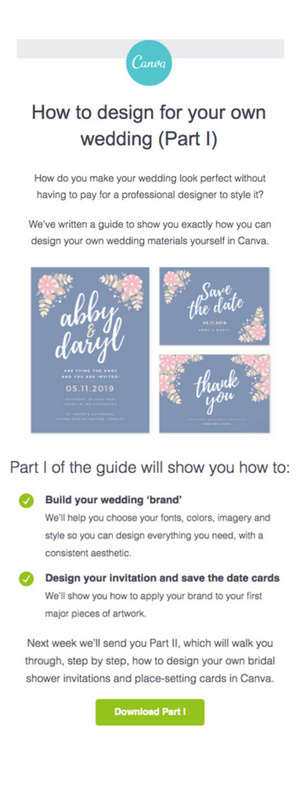
My friends say it’s simply because it was wedding season around; I prefer to be logical!
3. Promotional Drip Campaigns
This is fairly popular.
I’m sure you have tons of emails announcing various promo codes and seasonal offers.
Come the end of the year, I’m sure you have already received multiple Halloween, Black-Friday, Christmas, and New Year promotional offers.
PS: Many find promotional emails annoying. I hated it when I received discounts after I upgraded to a premium plan of a particular landing page building tool. It was annoying. Also, emails that are clustered with images and bright colors hurt eyes.
Pro Tip: Ensure you are sending your promo emails to people who will engage with the same.
It makes no point to send a huge discount offer to someone who has already paid for that same service/product.
Also, nicely designed emails aligning with your brand proposition and the season work well.
For instance, look at this email from Urban Ladder. Oh! That lovely way of saying a Christmas Story. The story is about how ‘Grinch’ stole Urban Ladder’s furniture and what happened next.
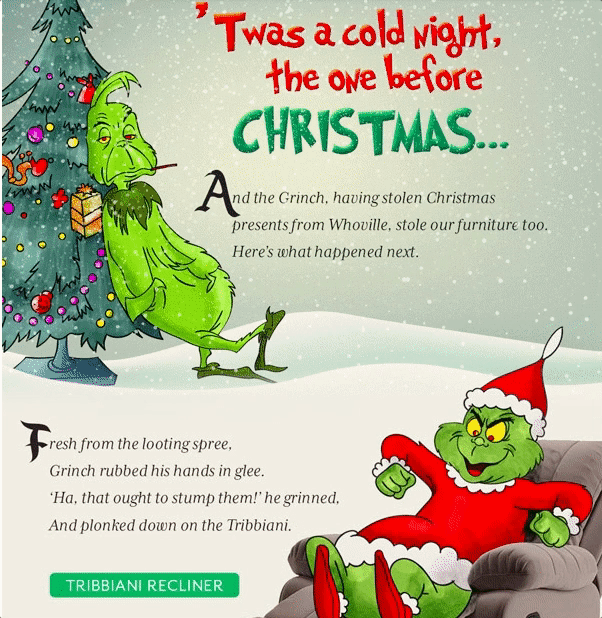
Read the full story here.
This is by far the best Christmas promotional email I have received.
It may be long, but emails like this make you read the whole story and also check the offers (which is the main purpose of this email).
Yet, look at the way they connect with the Christmas Spirit.
Do you want to find contact information for promotional drip campaigns?
LeadFuze is a free service that helps businesses find the best contact information for their promotional drip campaigns. It has access to over 1,000 databases and can help you find what you need in seconds.
When it comes to finding contact information, this tool got your back! You won’t be disappointed with its fast and accurate results. And if you don’t like what it found, just let them know and LeadFuze will keep looking until it gets it right!
4. Educational and Awareness Drip Email Campaigns
These emails are solely targeted towards educating and creating brand awareness after a visitor subscribes or signs up (usually designed for bulk sending).
However, certain lead behavior is taken into consideration while segmenting leads for these emails.
Some leads might require basic educational information about the brand, while others might engage with a more narrowed-down content piece.
For instance, when you sign up with a brand, you receive emails on overall industry aspects.
Slowly as you start engaging, your email content narrows down as per your interests.
As more time passes and you start using the brand/upgrade to a premium version, you get emails that are industry-related and are also concentrated on how better you can use that tool/services for better results.
5. Re-Engagement Campaigns
You must have some leads that were once very active, but suddenly stopped engaging?
To trigger engagement, you need to know why they stopped being active in the first place.
Maybe they did not get what they expected. Or maybe the content in your last email was not aligned with their interests.
In such cases, creating a re-engagement drip campaign often helps in rekindling old connections in a smarter way.
You can conduct an A/B test with a handful of leads before you send it to the entire list.
4 Advanced Lead Nurturing Campaign Strategies
1. Create personas
Before you can create your lead nurturing email sequence, you must first understand who your ideal leads are.
You can do this by creating detailed personas of your target market.
Think about how you can segment them into meaningful groups to make your lead nurturing campaign more personalized and poignant.
What are your ideal lead’s needs? Pain points? Goals? Do they hold a certain job title? Are there certain topics they are interested in?
Think about your persona when creating sign-up forms for your website.
What questions can you ask your leads to help you assign them the correct persona?
You obviously can’t get everything in a sign-up form, since quick and easy is expected, but you can glean some gems that will make it easier to segment them.
Once you’ve created your persona, zero in on the few properties that would be hardest to determine without being explicitly told. Those are the ones to put on your sign-up form.
2. Segment existing content
Segmenting your content is nearly as important as segmenting your list for your lead nurturing campaign.
The process is nearly the same as well.
Make a list of your existing content: blog posts, videos, webinars, white papers, industry news.
Anything that could be used to educate or entertain your prospect in some way.
Once you have your list, start assigning funnel sections to each piece.
Think about which portion of your sales process would most benefit from a particular piece of content.
If you were in the researching phase, would you want a webinar of the benefits of your service? Or would you rather have a white paper or blog post discussing why you need such a service in the first place?
You should also segment your content based on who would want it and what it addresses.
An industry analysis is probably more suited to someone in management or marketing, while engineering would appreciate a white paper on technical troubleshooting or research into an up-and-coming solution.
What pain points does your content address?
Does it offer solutions or just further insight into the problem?
Who would want to read or watch it? Is it for CEOs or IT specialists?
All of these questions and many more will help you figure out where your content belongs in your lead nurturing campaign sequence.
You should definitely be thinking about your personas when segmenting the content.
Ask yourself whether your ideal lead within your lead nurturing campaign would be interested in each individual piece of content.
If yes, add it to the list. If no, consider your other personas until you find one that fits.
If it’s not relative or informative to any of them, then leave it out.
There’s no need to squeeze all of your content into your lead nurturing strategy.
After determining where your content fits in the sequence, try as hard as you can to make all of your content available on your website, rather than sending leads to a third party such as LinkedIn or YouTube.
Sending them away from your website could lead to hours of cat videos instead of meaningful browsing of your site.
3. Decide on your timeline
If you’ve been in business for any decent length of time, you should have a good idea of how long prospects take to move through your sales funnel.
Use this knowledge to determine the best length for nurturing leads.
For example, if top-of-funnel prospects generally move to the middle of the funnel or consideration phase after 2 months, your lead nurturing sequence for top-of-funnel should be 2-2.5 months long.
Knowing the length of your campaign in real-time can help you decide the frequency and number of your emails.
A 2-week nurture marketing campaign will have fewer emails than a 4-month one.
Keep in mind the lead nurturing best practices we discussed last week.
The recommended frequency is between 6 and 45 days for longer campaigns.
Shorter ones will have an increased frequency, but in most cases, you probably won’t want to email prospects every day.
The last thing to consider with your timeline is how you will move your prospect through the funnel.
Your nurture system should naturally lead the prospect to the next step in the sales process.
Craft calls to action that help you determine when the prospect is ready to move to the next stage, such as downloading content that you’ve assigned to the next funnel segment.
4. Create your drip campaign emails
You should create a variety of emails for your lead nurturing programs that will keep your customers engaged and entertained.
Depending on where they are in the buying process, your leads will be interested in different things. Use this to craft emails that speak to them and their current needs.
12 Ways to Nurture Customer Relationships After a Sale
You did it!
You closed that deal you have been working on for a month.
The skies have parted, the birds are singing — you are the man (or woman)!
Does life get any better than here at this moment?
Well…yes.
Enjoy your 15 minutes of office fame and then get ready for the hardest part — customer retention.
It’s not enough to collect your commission check and jump to the next prospect (though that certainly is the enjoyable part).
You need to develop a great rapport with your customer that will keep them coming back for more.
Don’t rely solely on the efforts of the marketing team to keep the customer happy.
As the point of contact, you should be working to nurture those relationships as well.
Even if you hand over your new client to the account management department it doesn’t mean you can’t still maintain a relationship.
Think of creating that positive customer relationship like courting someone.
Yes, courting.
For the millennials out there, that’s the act of impressing and winning over the object of your affection.
It’s this crazy little thing our parents and grandparents once did.
It’s okay… I’m technically a millennial myself 🙂
Check out these 10 tips for nurturing sales leads, customer relationships and you can once again go back to celebrating your sales rockstar status!
1 Gain and maintain trust

Of course, the key to a great relationship is trust.
You wouldn’t surround yourself with questionable people in your personal life, right?
If a customer isn’t 100% sure that you are trustworthy, your relationship isn’t going to be a healthy one.
So how do you accomplish this trust?
Building a relationship means giving advice when it isn’t an attempt to close a deal.
It means listening to the client and developing yourself as an expert in their eyes.
While your goal is of course to maintain a professional relationship, it doesn’t mean you can’t joke, laugh or act like an actual person when you are speaking with your customers.
No one likes a sales robot, don’t be afraid to let your personality shine through.
Editors Note from Josh Slone: On a personal note, I know for a fact that this works.
While working for a company as a long-time client of a popular email platform, I attended 6 years of sales conferences where I had the chance to meet up with my sales rep.
He was funny, personable and made me love the company more.
I looked forward to clearing my schedule for a call because I was always learning something from him!
Every sales call with him after that initial meeting and his follow-up afterward, I related to him on a more personal level, trusted him when he offered additional add-ons, and continued to reach out with questions I came across.
Point of the story = be a person, not a sales robot and your customers will love you for the personal touch!
2 Over-deliver always

It’s no wonder that as long as we have been in the workforce we have been beaten over the head with the cliche “under promise and over-deliver.”
When it comes to keeping customers happy, this should truly be our anthem.
Maintaining a great relationship once you’ve closed the sale, means that the result of the purchase needs to live up to expectations.
This is where overdelivering comes in.
You never want your client to feel like you mislead them into believing they were getting something wonderful when really the result is so-so.
The older under promise over deliver method is not the best method.
Underpromising isn’t going to help, in fact, it could actually hurt but over-delivering should be something you strive for each time.
Every salesperson can deliver what’s promised but you will stand out when you prove you are more than a service provider.
Exceed expectations always and your customers will keep coming back again and again.
3 Create Google alerts for their company news

If you are working with a larger company, the easiest way to make sure you are up-to-date is to create a Google Alerts notification.
If you haven’t done this before, it’s actually really simple, as this Google Alerts guide shows you.
Google News allows you to customize the news that you see.
Say your client is American Airlines for example. You create an alert for American Airlines news and you will be notified anytime news is reported on the company.
This makes staying up-to-date with company happenings as easy as simply checking your notification.
Next time you talk to the customer, you’ll be knowledgeable about any new direction they may be going and it may even offer you an opportunity to upsell!
4 Keep consistent contact
Don’t be afraid to reach out periodically. Maintaining consistent contact with your customers is a good way to stay front of mind.
A word of warning on this however.

There’s a fine line between consistent contact and bothering someone.
Know your customer and feel it out.
Chances are, they are just as busy as you. Don’t sabotage your efforts by driving them crazy, but certainly checking in now and again is not going to cause any harm.
Be aware of the messaging and frequency with which your account management or marketing department is reaching out and follow up when there is a new update or product rolled out.
Coordinating all your customer touch points will greatly help your relationship in the future.
Additionally, every time you close a sale, be sure you are connecting on LinkedIn. This is the easiest and most professional way to maintain contact without interrupting their daily lives.
5 Continue to learn with each and every interaction

When you really begin to listen when a customer talks, you will learn what’s important to them.
When you really begin to listen when a customer talks, you will learn what’s important to them. Share on XFinding mutual interests is a great way to engage in discussions not solely related to work. You both have the same favorite sports team? Perfect.
Having a common ground to start from will help nurture your relationship.
6 Offer advice when you can help
Relationships flourish when your clients look to you as not just a salesperson but an authority in your field.
Become an adviser whenever possible. One great trick that is often underutilized in sales is referring your customers to other customers when you can.
Part of building relationships is learning more about your customers.
Keep a collection of business cards (or something more high tech if you like) and when you hear of a need one company has, refer them to another.
You have a client who builds homes but doesn’t paint them? Well, refer them to a handyman who does business with you.
Now you are nurturing two relationships at once!
7 Utilize referral incentives

As salespeople, we rely heavily on referrals to grow our customer base.
Not everyone is going to give you contact information at the drop of a hat but when you offer referral discounts, this sweetens the deal just enough.
Everyone has their own take on the best referral methods but the type of incentive you offer must match the type of business you run.
Makes sense, right?
The best way to discover the right referral incentive is to test and then test some more.
The best way to discover the right referral incentive is to test and then test some more. Share on XThis could mean offering a certain percentage off, including an upgrade or credit toward future purchases, or really anything that would pique the interest of your customer and make them want to take advantage of the opportunity.
Above all else, don’t forget the importance of a good old fashioned thank you once the referral has come your way.
8 Use the upsell opportunity
Knowing your customer will naturally lend itself to the ability to upsell.
When you see areas of a client’s business that you can improve upon with a product or service you offer, you have the best opportunity to upsell.
When done strategically, your customer will appreciate your suggestions and once again, look at you as more than a service provider, but an adviser as well.
9 Manage expectations
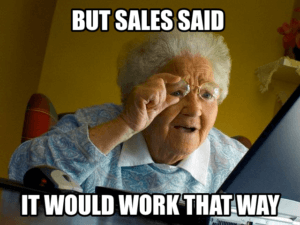
One of the very first aspects of building a relationship is managing customer expectations.
One of the very first aspects of building a relationship is managing customer expectations. Share on XFind out exactly what it is the client expects from you — it’s as simple as that.
Throughout the process you will have the ability to get to know your customer even better and learn their priorities and what it takes to make them happy.
Make realistic promises of how you can be of assistance and offer consistency.
There are too many variables in every company, when it comes to purchasing from you, companies appreciate getting exactly what they expect. It’s a stability that they can count on.
10 Target the leads based on what motivated them to buy the first time
Yeah, it sounds simple when it’s all spelled out like that, but it’s surprising how often this doesn’t factor into the nurture campaign thought process.
The holidays are bound to be filled with impulse buyers, so see if you can reel them in again with another tempting impulse sale. Did they click straight through from an email campaign to buy? Try to replicate a similar campaign with your newest offerings.
Maybe they were a social media shopper. Did they love the free shipping on orders over $50 that you advertised to them on Facebook? Show them a new round of products with a similar deal and see if you can get them to engage again.
Whatever convinced them the first time, see if it will work again with other related products.
11 Surveys
 Customer surveys can be a bit bulky and unwieldy. But they’re great for lead nurturing because you learn so much about what people like and dislike about your brand.
Customer surveys can be a bit bulky and unwieldy. But they’re great for lead nurturing because you learn so much about what people like and dislike about your brand.
12 Don’t underestimate a thank you note
I don’t care what year it is, as long as we still have paper and pens available to us, a handwritten thank you note will continue to go a long way during your nurturing drip campaign.
Yes, emails may be faster but in our digital society, actually sending a snail mail note is unusual and therefore is noticed.
Whether it’s after closing a deal with a customer or in response to a referral, take the time to write that thank you note.
A little bit of time and effort on your part can go a long way during your lead nurturing campaign relationship in the long run.
If you forget all else, remember this — when in doubt, act like a human.
Simply put, consider the lead nurturing campaign relationships you have with the most important people in your life.
Sure, they all have different dynamics that make them work but they rely on the same basic principles — trust, respect, consistency, gratitude, and compassion.
8 Effective Lead Nurturing Do’s and Don’ts
50% of leads are not ready to buy when you initially contact them.
What are you doing if you can’t convert leads right away?
If your answer is “nothing,” you are missing out on a huge number potential sales.
By instituting an automated lead nurturing campaign sequence, you can guide those prospects through the buyer’s journey, while earning their trust and ensuring you reach them at the right time.
To help you along the way, here are some of the main the do’s and don’ts on how to nurture leads.
Lead Nurturing Do’s
1. Segment your list
Use filters in your mailing list program or CRM to filter your leads by their buyer traits such as industry or job function.
This can help you create lead nurturing campaign sequences specific to each type of buyer.
You should also be segmenting your list by what stage of the buying funnel a prospect is currently in. By doing this, you can include relevant offers such as demos, free trials, or coupons to those leads who have progressed further into the funnel.
2. Use plain text emails
Consider staying away from HTML-based emails.
Plain text emails generally look more genuine to those receiving them during a lead nurturing campaign. Plus, you can save all that design time and put it towards producing amazing content for the emails, instead of just pretty pictures.
Along with plain text, use plain English.
Keep the written content concise and simple to understand. PrintWand suggests keeping your email simple enough to be understood by a 7th grader.
Not sure if your text is simple enough? Try editing it using the Hemingway App. This free to use tool gives your text a readability score. The lower the number, the easier it is to read. The app also give various suggestions on how to make your writing clearer, stronger, and easier to read.
3. Keep permission to stay in contact
Don’t lose the one thing you have going for you right now: your lead has given you permission to stay in touch.
This is a big deal. 53% of leads will stop responding as soon as the information becomes irrelevant.
Make sure you are sending your leads relevant and timely information that will keep them subscribed and opening emails from you.
Relevant lead nurturing campaign emails have 4 to 10 times the response rate of standard email blasts.
Couple email with other touch points such as direct mail, social media, and webinars to feed information in different forms.
4. Make your business a thought leader
Give your leads a reason to keep opening your emails.
Provide them with quality, thought-provoking content that shows you to be an authority in your niche.
Don’t stray too far from the product or service that got the lead to respond in the first place.
Instead, offer them heavy hitting guides and tools that they can use as they move through the buying stages. This is paramount to creating a great lead nurturing campaign.
Lead Nurturing Don’ts
5. Email leads every day
Be timely with your emails. Emailing leads every day is the fastest way to get them to unsubscribe.
In fact, Pardot recommends an email time of 6 to 45 days, while Marketing Advocate suggests sending no more than 9 to 12 emails per quarter.
Pay attention to how much you’re emailing your future customers during your lead nurturing campaign.
Now, this bears testing. In fact, LeadFuze DOES send daily emails the first 7 days before then slowly spreading them out to every days and eventually setting in on a weekly cadence.
We tested slower send times between emails, and saw a decrease in conversion. Does it piss some people off? Sure… but the numbers speak for themselves at the end of the day.
6. Send every lead the same email
This goes hand in hand with segmenting your list.
The same content won’t resonate with everyone. Make sure to differentiate your content based on who it’s being sent to.
Do more than just change the name and industry.
Try writing new emails designed specifically for each of your list segments. Click here to take a look at some great email templates.
In our marketing automation system, we can actually change content within the same email based on different traits of our signups. For example, if you are already signed up for a trial, when we send a lead nurturing email for our blog content, we will not ask you to sign up for a trial to get 25 leads free.
However, if you have NOT signed up for 25 free leads, then our lead nurturing emails invite you to sign up for those leads.
LeadFuze is a software solution to help you build lists of accurate leads automatically, while integrating with sales outreach tools to allow you to contact those freshly verified leads.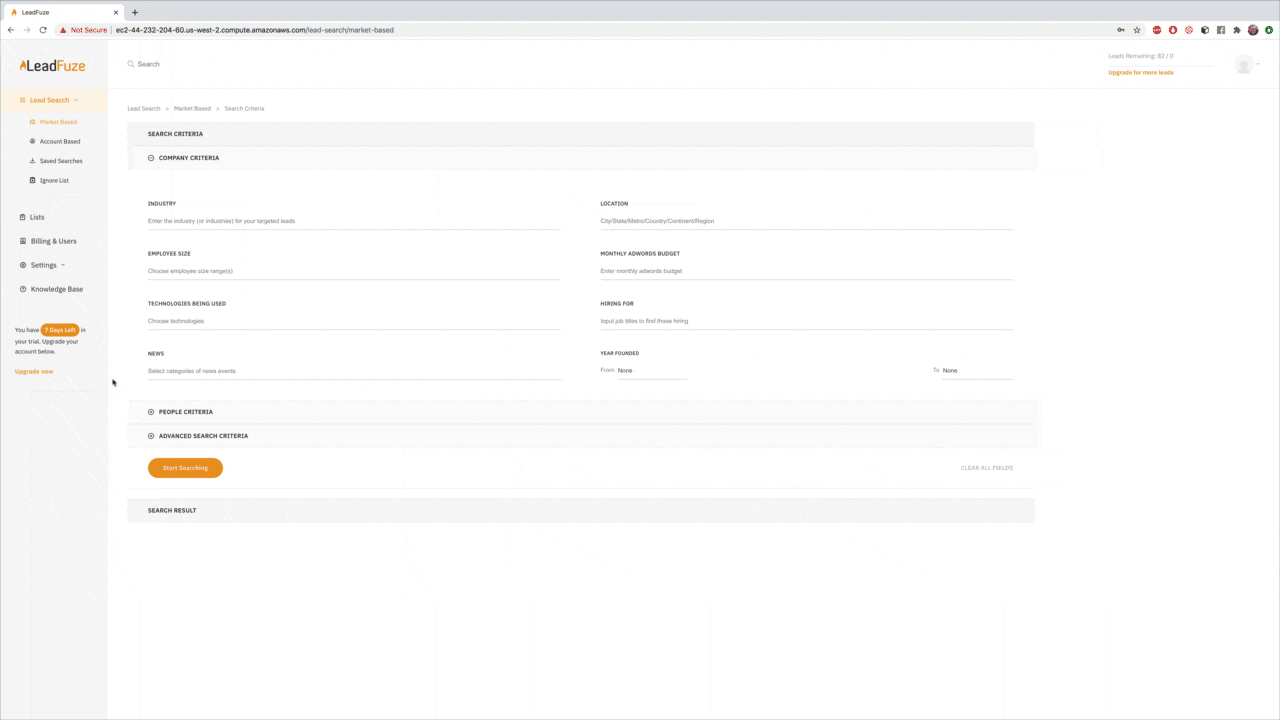
7. Leave your team out of the loop
Your marketing team will be the primary task owner for your lead nurturing campaign, but you should still involve your sales team when designing the nurturing sequence.
Your salespeople can tell marketing the best way to approach your prospects’ needs and pain points.
Including them in the creation of your sequence makes it easier and more effective than if marketing does it alone.
8. Start lead nurturing without content to back it up
You should start generating content even before you have a lead nurturing system in place.
That way, when you do start your sequence, you’ll have plenty of ready-made items to include in your emails or social posts.
Your content can include blog posts, images, infographics, anything that you could send to prospects as a new source of information or knowledge.
Conclusion
Hopefully, this guide can help you put together a killer lead nurturing campaign. The whole lead nurturing process can be broken down into 7 distinct steps:
- Create personas for your ideal leads.
- Segment your existing content by funnel location and what issues it addresses.
- Decide on your timeline, frequency, and call to action.
- Create a variety of emails to educate and entertain your prospects.
- Start running your campaigns
- Evaluate the results.
- Rinse and repeat.
If you’re stuck on any of these lead nurturing campaign steps, check out the following posts for more information:
- What Content Should You Use In Your Lead Nurturing Emails from Hubspot
- Recipe for Rockstar Lead Nurturing Campaigns from Savvy Panda
- Lead Nurturing Examples: The Good and The Bad from Brainrider
- 6 Lead Nurturing Emails Every Business Should Be Sending from Hubspot
What we didn’t dive into is how to implement lead scoring as part of the lead nurturing process. Read that link to learn more about lead scoring, but in a nutshell…
Once you’ve nurtured leads long enough, they will reach lead scoring benchmarks you’ve set up. Reaching a high enough lead score means they should be handed over to your sales team.
This goes into the next step of the sales process. We’ll wrap up this guide on lead nurturing right here. ?
This post was put together with contributions from Chris Molitor, the Vice President of Business Development at Red Stag Fulfillment, and Ankit Prakash, a technology entrepreneur at Aritic.
Want to help contribute to future articles? Have data-backed and tactical advice to share? I’d love to hear from you!
We have over 60,000 monthly readers that would love to see it! Contact us and let's discuss your ideas!
